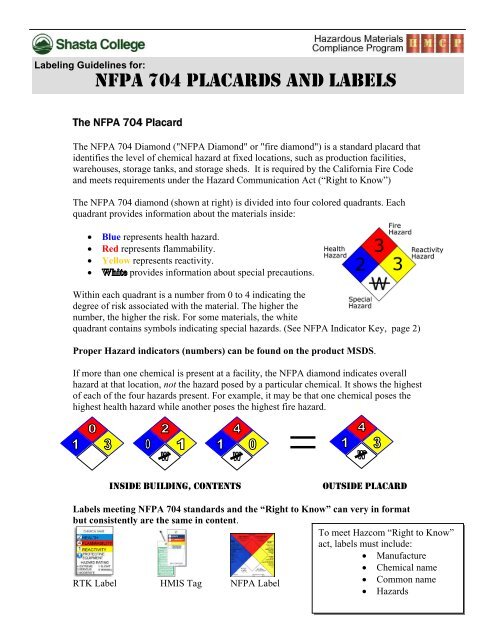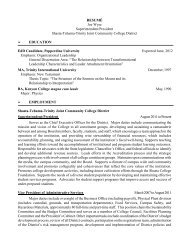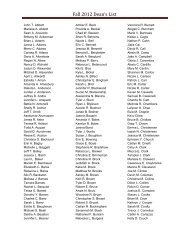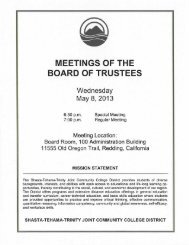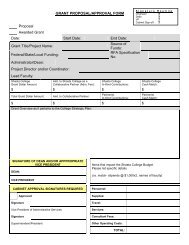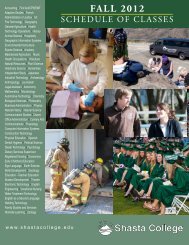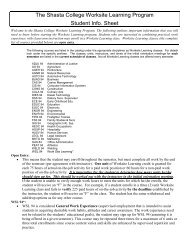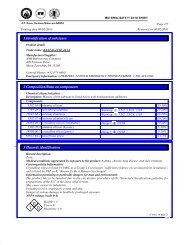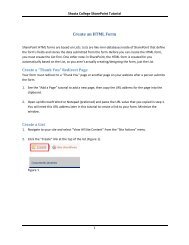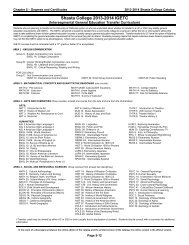NFPA 704 Placards and Labels - Shasta College
NFPA 704 Placards and Labels - Shasta College
NFPA 704 Placards and Labels - Shasta College
You also want an ePaper? Increase the reach of your titles
YUMPU automatically turns print PDFs into web optimized ePapers that Google loves.
Labeling Guidelines for:<br />
<strong>NFPA</strong> <strong>704</strong> PLACARDS AND LABELS<br />
<strong>NFPA</strong> <strong>704</strong> PLACARDS AND LABELS<br />
The <strong>NFPA</strong> <strong>704</strong> Placard<br />
The <strong>NFPA</strong> <strong>704</strong> Diamond ("<strong>NFPA</strong> Diamond" or "fire diamond") is a st<strong>and</strong>ard placard that<br />
identifies the level of chemical hazard at fixed locations, such as production facilities,<br />
warehouses, storage tanks, <strong>and</strong> storage sheds. It is required by the California Fire Code<br />
<strong>and</strong> meets requirements under the Hazard Communication Act (“Right to Know”)<br />
The <strong>NFPA</strong> <strong>704</strong> diamond (shown at right) is divided into four colored quadrants. Each<br />
quadrant provides information about the materials inside:<br />
• Blue represents health hazard.<br />
• Red represents flammability.<br />
• Yellow represents reactivity.<br />
• provides information about special precautions.<br />
Within each quadrant is a number from 0 to 4 indicating the<br />
degree of risk associated with the material. The higher the<br />
number, the higher the risk. For some materials, the white<br />
quadrant contains symbols indicating special hazards. (See <strong>NFPA</strong> Indicator Key, page 2)<br />
Proper Hazard indicators (numbers) can be found on the product MSDS.<br />
If more than one chemical is present at a facility, the <strong>NFPA</strong> diamond indicates overall<br />
hazard at that location, not the hazard posed by a particular chemical. It shows the highest<br />
of each of the four hazards present. For example, it may be that one chemical poses the<br />
highest health hazard while another poses the highest fire hazard.<br />
.<br />
INSIDE BUILDING, CONTENTS<br />
OUTSIDE PLACARD<br />
<strong>Labels</strong> meeting <strong>NFPA</strong> <strong>704</strong> st<strong>and</strong>ards <strong>and</strong> the “Right to Know” can very in format<br />
but consistently are the same in content.<br />
To meet Hazcom “Right to Know”<br />
act, labels must include:<br />
• Manufacture<br />
• Chemical name<br />
RTK Label HMIS Tag <strong>NFPA</strong> Label<br />
• Common name<br />
• Hazards
<strong>NFPA</strong> INDICATOR KEY<br />
HEALTH HAZARD FLAMMABILITY REACTIVITY SPECIAL<br />
4 - Materials which on<br />
very short exposure<br />
could cause death or<br />
major residual injury<br />
even through prompt<br />
medical treatment were<br />
given.<br />
4 - Materials which<br />
will rapidly or<br />
completely vaporize at<br />
atmospheric pressure<br />
<strong>and</strong> normal ambient<br />
temperature, <strong>and</strong><br />
which will burn.<br />
FLASH POINT< 73<br />
4 - Materials which<br />
are readily capable of<br />
detonation or of<br />
explosive<br />
decomposition or<br />
reaction at normal<br />
temperatures <strong>and</strong><br />
pressures.<br />
Specific chemical<br />
hazards, special<br />
information <strong>and</strong><br />
personal protective<br />
equipment will be<br />
noted in this<br />
section. Specific<br />
hazards <strong>and</strong> their<br />
symbols are as<br />
follows:<br />
OX- Oxidizer<br />
3 - Materials which on<br />
short exposure could<br />
cause serious<br />
temporary or residual<br />
injury even though<br />
prompt medical<br />
treatment were given.<br />
3 - Liquids <strong>and</strong> solids<br />
that can be ignited<br />
under almost all<br />
ambient temperature<br />
conditions.<br />
FLASH POINT< 100<br />
3 -Materials that can<br />
detonate or explode<br />
but require a strong<br />
initiating source, or<br />
must be heated<br />
under confinement<br />
before initiation, or<br />
react explosively with<br />
water.<br />
ACID - Acid<br />
ALK - Alkali<br />
COR- Corrosive<br />
-W- No Water<br />
Radioactive<br />
2 -Materials which on<br />
intense exposure could<br />
cause possible residual<br />
injury unless prompt<br />
medical treatment is<br />
given.<br />
1 -Materials which on<br />
exposure would cause<br />
irritation but only minor<br />
residual injury even if<br />
no treatment is given.<br />
0 -Materials which on<br />
exposure under fire<br />
conditions would offer<br />
no hazard beyond that<br />
of ordinary<br />
combustibles.<br />
2 -Materials that must<br />
be moderately heated<br />
or exposed to<br />
relatively high ambient<br />
temperatures before<br />
igniting.<br />
FLASH > 100 < 200<br />
1 -Materials that must<br />
be preheated before<br />
ignition can occur.<br />
FLASH POINT > 200<br />
0 -Materials that will<br />
not burn.<br />
2 -Materials that are<br />
normally unstable<br />
<strong>and</strong> readily undergo<br />
violent chemical<br />
changes but do not<br />
detonate; also<br />
materials that may<br />
react violently with<br />
water.<br />
1 -Materials that are<br />
normally stable, but<br />
can become unstable<br />
at high temp. <strong>and</strong><br />
pressures, or may<br />
react with water with<br />
some release of<br />
energy.<br />
0 -Materials that are<br />
normally stable even<br />
under fire explosive<br />
conditions, <strong>and</strong> that<br />
are not reactive with<br />
water.<br />
HMIS<br />
A=Safety glasses<br />
B=Safety glasses,<br />
Gloves<br />
C=Glasses, gloves<br />
Protective apron<br />
D=Face shield,<br />
Gloves, apron<br />
E=Glasses, gloves<br />
Dust respirator<br />
F=glasses, gloves<br />
Respirator, apron<br />
G=Glasses, gloves<br />
Vapor respirator<br />
H=Goggles, gloves<br />
Apron, respirator<br />
I =glasses, gloves<br />
APR<br />
K=supplied air,<br />
Mask or hood<br />
Suit <strong>and</strong> boots<br />
Or symbols may be<br />
used<br />
DWFreeman 2009


